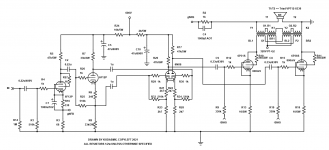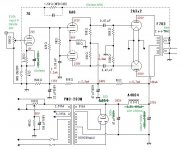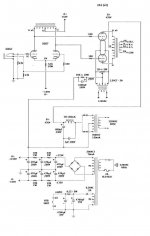Hi all, any suggestions/experiences/recommendations for a drive tube in a 2a3 push pull amp? I have seen so many options... 20A.. EL3n...6sn7...
Much thanks!
cheers filip
Much thanks!
cheers filip
6F12P into 6SN7 is what I use on similar amps...
Here's a schematic, just replace the output stage with the 2A3 stage 🙂
I have PCBs if you want them...
The 6P31S doesn't like 80mA, it's a type from the 6P36S version.
Here's a schematic, just replace the output stage with the 2A3 stage 🙂
I have PCBs if you want them...
The 6P31S doesn't like 80mA, it's a type from the 6P36S version.
Attachments
Last edited:
6SN7 in a Brook 12A
Try a Brook 12A. They sound wonderful and use the 6SN7. The Choke that appears to be a transformer in the middle is just a choke. It has 14dB of feedback.
The Brook Amplifier
Try a Brook 12A. They sound wonderful and use the 6SN7. The Choke that appears to be a transformer in the middle is just a choke. It has 14dB of feedback.
The Brook Amplifier
An ECC99 can easily drive a properly biased push pull set of 2A3 tubes.
I repaired a friend's stereo push pull 2A3 amplifier.
It had ECC99 tubes for the drivers.
It used Monolith Magnetics output transformers.
That was a very sweet amplifier.
For me, I would want mono-blocks, no more hernias for me, please.
I repaired a friend's stereo push pull 2A3 amplifier.
It had ECC99 tubes for the drivers.
It used Monolith Magnetics output transformers.
That was a very sweet amplifier.
For me, I would want mono-blocks, no more hernias for me, please.
Last edited:
I have been thinking to build this amp as mono block. You can get schematic in the download section, no sign up needs
2A3 PP Push-Pull Tube Amplifier 15W Kit
2A3 PP Push-Pull Tube Amplifier 15W Kit (Stereo)_Power Amplifier Kit_Tube Amplifier Kit_Analog Metric - DIY Audio Kit Developer
2A3 PP Push-Pull Tube Amplifier 15W Kit
2A3 PP Push-Pull Tube Amplifier 15W Kit (Stereo)_Power Amplifier Kit_Tube Amplifier Kit_Analog Metric - DIY Audio Kit Developer
An ECC99 can easily drive a properly biased push pull set of 2A3 tubes.
I repaired a friend's stereo push pull 2A3 amplifier.
It had ECC99 tubes for the drivers.
It used Monolith Magnetics output transformers.
That was a very sweet amplifier.
For me, I would want mono-blocks, no more hernias for me, please.
6N6P and 5687 are both similar to the ECC99, and still readily available. Mu of 16 to 20, low rp, can sink all the current needed.
I had one that was a 5687 (later 6N6P) LTP with a center-tapped choke as the plate loads, DC-coupled to a PP pair of 2A3s, into a Tango 45 watt OPT. I ran that happily for nearly 30 years, but I got stupid and started messing with it, and somehow managed to screw some things up. I should build that again. It needed a preamp with 10dB or so gain. I think it reached full power out with about 3.5V rms input, so 4X gain from a preamp would require 1V input. Maybe a 6V6-triode or 12B4A line amp. Or put an input transformer to split phase and provide a little voltage step-up.
Or do something else.
--
Attachments
rongon,
Nice schematic.
I really like that idea of a center tapped choke.
Instead of an interstage transformer with its extra windings, capacitance, and leakage reactance, you used a center tapped choke.
I might have to have someone custom wind one of those for me.
But how do you balance the DC currents?
1. In the center tapped choke?
2. in the push pull output transformers?
Or, do you use Air Gapped chokes, and Air Gapped push pull output transformers?
Nice schematic.
I really like that idea of a center tapped choke.
Instead of an interstage transformer with its extra windings, capacitance, and leakage reactance, you used a center tapped choke.
I might have to have someone custom wind one of those for me.
But how do you balance the DC currents?
1. In the center tapped choke?
2. in the push pull output transformers?
Or, do you use Air Gapped chokes, and Air Gapped push pull output transformers?
I never thought much of the 12a-7 tubes but since seeing smoking-amp's comment on the suitability of the 12AT7 for differential service I tried it as an SRPP input/driver for a 2a3 amp and it sounds very good. It would depend on what your interstage coupling scheme is but the 12AT' might be worth putting on your list of possibles.
rongon,
Nice schematic.
I really like that idea of a center tapped choke.
Instead of an interstage transformer with its extra windings, capacitance, and leakage reactance, you used a center tapped choke.
I might have to have someone custom wind one of those for me.
But how do you balance the DC currents?
1. In the center tapped choke?
2. in the push pull output transformers?
Or, do you use Air Gapped chokes, and Air Gapped push pull output transformers?
The center-tapped chokes are actually OPTs for push-pull EL84s (secondaries left open). I would use 12AT7 as the LTP if I could, but the primary inductance would have to be way up there at like 250H or higher to get decent bass response. I have a pair of Tango TC-60 chokes waiting to replace the repurposed OPTs (lucky me), but the LTP will have to use a triode with very low rp.
In the final version I used a CCS in the tail of the 5687 LTP (later changed to 6N6P). I'm relying on using reasonably well-matched twin-triodes for balance. I know, not a great answer. It worked well with the CCS.
The one thing I'm concerned about is weird ultrasonic resonances from having the center-tapped plate choke loading an LTP phase splitter. I think if an input transmitter splits phase and the 5687 pair is a differential amp with balanced inputs, that should work better. I experimented with a pair of Edcor 10k:10k trannies at the inputs, and that worked. I also tried a simplified version of SY's Impasse preamplifier, which worked but added a lot of gain, so I ended up with just a bit too much low-level hum from the speakers.
I think I should re-do this using a pair of Jensen 1:1 input transformers or similar to split phase, with a CCS in the tail of the 6N6P triodes.
Fixed bias (as opposed to auto bias) is preferred for 2A3 PP because it yields more output power with less distortion. However, fixed bias requires low DC resistance from grid to ground, not more than 50 K. With RC coupling, this low resistance demands a driver of low output impedance, like a beefy triode idling at tens of milliamperes.
However, 2A3 does not need a beefy driver with transformer coupling. Transformer provides low grid to ground DC resistance; it is the safest way of implementing fixed bias. Differential driver with a pair of wimpy Type 30s is sufficient to drive a quad of 2A3s in parallel PP - if transformer-coupled. Of course, transformer coupling demands tubes with relatively low Rp at relatively low plate current, such as 01A, 26, 56, or triode-connected 6C6.
Transformer coupling has another very important advantage: it virtually doubles the B+ voltage of the driver. Because 2A3 requires high input swing (about 60 V peak in Class AB1), a good driver must have high B+ rail. By contrast, RC-coupled driver's B+ is virtually halved due to voltage drop in plate resistor.
However, 2A3 does not need a beefy driver with transformer coupling. Transformer provides low grid to ground DC resistance; it is the safest way of implementing fixed bias. Differential driver with a pair of wimpy Type 30s is sufficient to drive a quad of 2A3s in parallel PP - if transformer-coupled. Of course, transformer coupling demands tubes with relatively low Rp at relatively low plate current, such as 01A, 26, 56, or triode-connected 6C6.
Transformer coupling has another very important advantage: it virtually doubles the B+ voltage of the driver. Because 2A3 requires high input swing (about 60 V peak in Class AB1), a good driver must have high B+ rail. By contrast, RC-coupled driver's B+ is virtually halved due to voltage drop in plate resistor.
I used to use interstage transformers to drive my 2A3 and 300B amplifiers.
I only have one interstage left now, I gave the others away.
I do not have any 2A3 or 300B amplifiers now.
I gave away my 300B tubes, but plan on building a 2A3 amp with DC powered filaments one of these days.
I like the square waves on RC coupled amplifiers, both SE and Push Pull. I only use RC coupling, not interstage, and not DC coupling.
I only have one interstage left now, I gave the others away.
I do not have any 2A3 or 300B amplifiers now.
I gave away my 300B tubes, but plan on building a 2A3 amp with DC powered filaments one of these days.
I like the square waves on RC coupled amplifiers, both SE and Push Pull. I only use RC coupling, not interstage, and not DC coupling.
I used to use interstage transformers to drive my 2A3 and 300B amplifiers.
I only have one interstage left now, I gave the others away.
I do not have any 2A3 or 300B amplifiers now.
I gave away my 300B tubes, but plan on building a 2A3 amp with DC powered filaments one of these days.
I like the square waves on RC coupled amplifiers, both SE and Push Pull. I only use RC coupling, not interstage, and not DC coupling.
What do you think of plate chokes and a good coupling cap?
For the dual triode phase inverter, with a low burden voltage real constant current sink (not a long tailed resistor with negative supply), I like the idea of a split choke. Saves B+ versus a resistor load. But as I said earlier in this thread, I would want the choke to have an air gap large enough to make up for the possible un-balanced plate currents.
The combination of CCS at the cathodes, and split choke plate loads gives some plate to plate linearization.
And yes, then I would prefer to use RC coupling to the output tube grids. I am not a fan of DC coupling (not for me). Many others use DC coupling very successfully, I prefer not to have to do that.
I have often used the metal encased 600V scope AC coupling caps, as coupling caps in my amplifiers.
The combination of CCS at the cathodes, and split choke plate loads gives some plate to plate linearization.
And yes, then I would prefer to use RC coupling to the output tube grids. I am not a fan of DC coupling (not for me). Many others use DC coupling very successfully, I prefer not to have to do that.
I have often used the metal encased 600V scope AC coupling caps, as coupling caps in my amplifiers.
Fixed bias (as opposed to auto bias) is preferred for 2A3 PP because it yields more output power with less distortion. However, fixed bias requires low DC resistance from grid to ground, not more than 50 K. With RC coupling, this low resistance demands a driver of low output impedance, like a beefy triode idling at tens of milliamperes.
However, 2A3 does not need a beefy driver with transformer coupling. Transformer provides low grid to ground DC resistance; it is the safest way of implementing fixed bias. Differential driver with a pair of wimpy Type 30s is sufficient to drive a quad of 2A3s in parallel PP - if transformer-coupled. Of course, transformer coupling demands tubes with relatively low Rp at relatively low plate current, such as 01A, 26, 56, or triode-connected 6C6.
Transformer coupling has another very important advantage: it virtually doubles the B+ voltage of the driver. Because 2A3 requires high input swing (about 60 V peak in Class AB1), a good driver must have high B+ rail. By contrast, RC-coupled driver's B+ is virtually halved due to voltage drop in plate resistor.
"Type 30" , sorry but is that the 30A tube that Emission Labs has (for instance)? much thanks!
Type 30 is on old DHT. An average/OK DHT but microphonic, with a wimpy filament current.
30, Tube 30; Rohre 30 ID3105, Triode, vacuum
For a driver tube I'd suggest the 2P29L with 3K Ri and can take 18mA current.
30, Tube 30; Rohre 30 ID3105, Triode, vacuum
For a driver tube I'd suggest the 2P29L with 3K Ri and can take 18mA current.
I'm watching this thread with interest.. I'm interested, as a enhancement in adapting my 12BH7A > ecc99 headphone amp with a 2a3 final small speaker stage at some point.
In the final version I used a CCS in the tail of the 5687 LTP (later changed to 6N6P). I'm relying on using reasonably well-matched twin-triodes for balance. I know, not a great answer. It worked well with the CCS.
You could add a pot between input stage cathodes with wiper to tail and adjust DC balance through anode load. At the output stage, you could use a filament transformer for each tube (CT) with a view to doing the same. Voila, DC balance.
- Home
- Amplifiers
- Tubes / Valves
- 2A3 oush pull drive tube?



